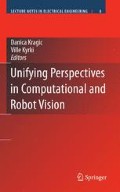This paper explains a vision-based method to obtain both topological and metric localization through a hierarchical process, presented in our previous work [17]. There, global localization is obtained with respect to a visual memory (a topological map built with sorted reference images). The global localization, sometimes known as the ”kidnapped robot problem”, intends to localize the robot only with the current acquisition of the sensors, without any knowledge of previous measurements, oppositely to the continuous localization tasks. The aforementioned localization hierarchy consists of an initial less accurate localization result, in terms of topological information (room identification), which applies object recognition techniques. The second localization result of the hierarchy is a more accurate metric localization. It is obtained through a SFM algorithm for 1D bearing only data [1], [4] based on the 1D trifocal tensor [6]. This kind of data is intuitively extracted from images, Fig. 8.1 shows two examples of 1D bearing only data. On the left, the orientation of point features in omnidirectional images, that is the more stable cue in that kind of images; on the right, another situation where using only 1D is convenient, the horizontal coordinate of vertical lines in conventional images, as these line segments usually have a clear orientation (x-coordinate) but they do not have accurate tips (y-coordinate).
The outline of this paper is as follows. Next section 8.2 is divided in two parts: subsection 8.2.1 details the process used to perform the room/scene recognition and subsection 8.2.2 explains the 1D trifocal tensor estimation and its SFM algorithms. In section 8.3, a brief description of the features that have been studied in our examples is given, followed by section 8.4 with several examples of localization results obtained applying the explained techniques. Finally section 8.5 concludes the work.
Access this chapter
Tax calculation will be finalised at checkout
Purchases are for personal use only
Preview
Unable to display preview. Download preview PDF.
References
Astr öm, K., Oskarsson, M.: Solutions and ambiguities of the structure and motion problem for 1d retinal vision. Journal of Mathematical Imaging and Vision 12(2), 121-135 (2000)
Bay, H., Tuytelaars, T., Van Gool, L.: Surf: Speeded up robust features. In: European Conference on Computer Vision, pp. 404-417 (2006). Http://www.vision.ee.ethz.ch/ surf/
Davison, A.J.: Real-time simultaneous localisation and mapping with a single camera. In: the IEEE Int. Conf. on Computer Vision, pp. 1403-1410 (2003)
Dellaert, F., Stroupe, A.: Linear 2d localization and mapping for single and multiple robots. In: IEEE Int. Conf. on Robotics and Automation, pp. 688-694 (2002)
DeSouza, G., Kak, A.C.: Vision for mobile robot navigation: A survey. IEEE Trans. on Patt. Analysis and Machine Intelligence 24(2), 237-267 (2002)
Faugeras, O., Quan, L., Sturm, P.: Self-calibration of a 1d projective camera and its application to the self-calibration of a 2d projective camera. IEEE Trans. on Pattern Analysis and Machine Intelligence 22(10), 1179-1185 (2000)
Fischler, M.A., Bolles, R.C.: Random sample consensus: A paradigm for model fitting with applications to image analysis and automated cartography. Comm. of the ACM 24, 381-395 (1981)
Grauman, K., Darrell, T.: The pyramid match kernels: Discriminative classification with sets of image features. In: IEEE Int. Conf. on Computer Vision, pp. 1458-1465 (2005)
Hartley, R., Zisserman, A.: Multiple View Geometry in Computer Vision. Cambridge University Press, Cambridge (2000)
Košeck á , J., Li, F.: Vision based topological Markov localization. In: IEEE Int. Conf. on Robotics and Automation, pp. 1481-1486 (2004)
Lowe, D.G.: Distinctive image features from scale-invariant keypoints. Int. Journal of Computer Vision 60(2), 91-110 (2004). Http://www.cs.ubc.ca/ lowe/keypoints/
Martínez Mozos, O., Triebel, R., Jensfelt, P., Rottmann, A., Burgard, W.: Supervised semantic labeling of places using information extracted from sensor data. Robotics and Autonomous Systems 5(55), 391-402
Mikolajczyk, K., Leibe, B., Schiele, B.: Local features for object class recognition. In: the IEEE Int. Conf. on Computer Vision, pp. 1792-1799 (2005)
Mikolajczyk, K., Schmid, C.: A performance evaluation of local descriptors. IEEE Transactions on Pattern Analysis & Machine Intelligence 27(10), 1615-1630 (2005)
Murillo, A.C., Guerrero, J.J., Sag ü és, C.: Robot and landmark localization using scene planes and the 1d trifocal tensor. In: IEEE/RSJ Int. Conf. on Intelligent Robots and Systems, pp. 2070-2075 (2006)
Murillo, A.C., Guerrero, J.J., Sag ü és, C.: Surf features for efficient robot localization with omnidirectional images. In: IEEE/RSJ Int. Conf. on Robotics and Automation, pp. 3901-3907 (2007)
Murillo, A.C., Sag ü és, C., Guerrero, J.J., Goedem é , T., Tuytelaars, T., Van Gool, L.: From omnidirectional images to hierarchical localization. Robotics and Autonomous Systems 55(5), 372-382 (2007)
Newman, P., Cole, D., Ho, K.: Outdoor slam using visual appearance and laser ranging. In: IEEE Int. Conf. on Robotics and Automation, pp. 1180-1187 (2006)
Opelt, A., Pinz, A., Fussenegger, M., Auer, P.: Generic object recognition with boosting. IEEE Transactions on Pattern Analysis and Machine Intelligence 28(3), 416-431 (2006)
Sag ü és, C., Murillo, A.C., Guerrero, J.J., Goedemé , T., Tuytelaars, T., Van Gool, L.: Localization with omnidirectional images using the 1d radial trifocal tensor. In: IEEE Int. Conf. on Robotics and Automation, pp. 551-556. Orlando, USA (2006)
Shashua, A., Werman, M.: Trilinearity of three perspective views and its associate tensor. In: IEEE Int. Conf. on Computer Vision, pp. 920-925 (1995)
Workshop-FS2HSC-data: IEEE/RSJ International Conference on Intelligent Robots and Systems (2006). Http://staff.science.uva.nl/ zivkovic/FS2HSC/dataset.html
Zivkovic, Z., Bakker, B., Kr öse, B.: Hierarchical map building using visual landmarks and geometric constraints. In: Proc. IEEE/RSJ Int. Conf. on Intelligent Robots and Systems, pp. 7-12 (2005)
Author information
Authors and Affiliations
Editor information
Editors and Affiliations
Rights and permissions
Copyright information
© 2008 Springer Science+Business Media, LLC
About this chapter
Cite this chapter
Murillo, A.C., Guerrero, J.J., Saguüés, C. (2008). Topological and Metric Robot Localization through Computer Vision Techniques. In: Kragic, D., Kyrki, V. (eds) Unifying Perspectives in Computational and Robot Vision. Lecture Notes in Electrical Engineering, vol 8. Springer, Boston, MA. https://doi.org/10.1007/978-0-387-75523-6_8
Download citation
DOI: https://doi.org/10.1007/978-0-387-75523-6_8
Publisher Name: Springer, Boston, MA
Print ISBN: 978-0-387-75521-2
Online ISBN: 978-0-387-75523-6
eBook Packages: Computer ScienceComputer Science (R0)

